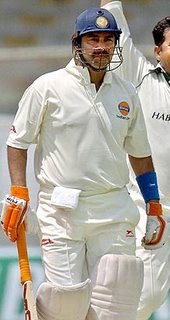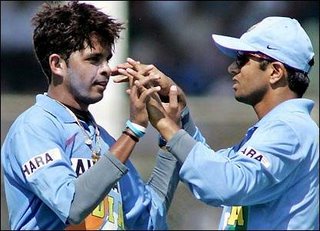 Kapildev Ramlal Nikhanj
Kapildev Ramlal Nikhanj
Born: 6 January 1959, Chandigarh
Major Teams: Haryana, Northamptonshire, Worcestershire, India.
Known As: Kapil Dev
Batting Style: Right Hand Bat
Bowling Style: Right Arm Fast Medium
Kapil Dev named Indian player of century 24 July 2002
London Wisden's decision to name all-rounder Kapil Dev as India's player of the century has been welcomed by the country's former Test players.
Kapil, the ex-captain who led India to their lone World Cup triumph in 1983, was picked ahead of former batsman Sunil Gavaskar and modern-day icon Sachin Tendulkar by a 35-member panel comprising international commentators and former players.
His peers said Kapil was the right choice because he could alter the result of a match single-handedly.
"I don't think anyone has won more matches for India individually," said former Test spinner Maninder Singh on Wednesday.
"He could change the nature of his game with his bowling, batting, fielding and captaincy. That puts him ahead of everyone else."
Kapil took 434 wickets at 29.64 apiece and scored 5,248 runs at an average of 31.05 in Tests.
He made his debut for India as a 19-year-old in the 1978-79 season against Pakistan. He played 131 Tests and 225 one-dayers in a career spanning over 16 years.
"I am very happy for Kapil, he richly deserved the award," said Madan Lal, a member of Kapil's World Cup-winning team and now a national selector.
"THE GREATEST"
"It's a good decision by the jury, there was never any doubt in my mind that Kapil is the greatest."
Kapil is the only cricketer in history to score more than 5,000 and take more than 400 wickets in Tests. His mark of 434 wickets stood as a record until West Indian Courtney Walsh surpassed it just two years ago.
"It's a very intelligent decision by the panel to name Kapil," said former Test opener Chetan Chauhan.
"Gavaskar, Kapil and Sachin were the frontrunners but because of his ability to contribute with both the bat and ball they have gone with Kapil."
Kapil's most memorable knock was an unbeaten 175 in the 1983 World Cup against Zimbabwe at Tunbridge Wells in England, where he rescued India from 17 for five to 266 in 60 overs.
Tendulkar won the people's choice award at a ceremony in London on Tuesday, while Gavaskar's team of 1985 - winners of the World Series Cup in Australia - was picked as the best Indian team of the century.
Tendulkar has scored 29 Test centuries and a world-record 33 one-day hundreds. Gavaskar, the first man to score 10,000 Test runs, has a world record 34 Test centuries. He played his last Test in 1987.
When Kapil Dev’s first coach Desh Prem Azad recommended that he should drink a lot of milk, Kapil’s father bought a buffalo to solve the problem. The incident had a deep impact on the young lad. And the determination to succeed gave India her best pace bowler ever.
With 684 wickets and almost 9,000 runs in both versions of the game, Kapil stamped himself as the best all-rounder in world cricket. His exploits also include leading India to the 1983 World Cup triumph at Lord’s. Best Batting performance in ODI: 175* vs Zimbabwe at Tunbridge Wells (18-6-1983).
It was, probably, the best innings ever to be played in a one-day match. India won the toss and elected to bat in the World Cup match. Kapil Dev came into bat with his side reeling at 17-5. The top five batsmen, which included Sunil Gavaskar, Krishnamachari Srikkanth, Mohinder Amarnath and Sandeep Patil, all fell for scores less than 10. Kapil went on to make 175 not out off 138 balls and turn around the match. At that point of time, it was the highest individual score made in a one-day match.
The second highest scorer of the Indian innings was Syed Kirmani, who made 24 not out. Sadly, there is not a single clipping or television footage available of this amazing innings, as the BBC were apparently on a strike that day and did not cover the match. The innings changed India’s fortunes in the 1983 World Cup. And, ironically, it is the only hundred that Kapil scored in one-dayers. Best Bowling performance in Tests: 9 for 83 vs West Indies at Ahmedabad (1983-84)
Nine scalps of the West Indian batting line-up that read Gordon Greednidge, Vivian Richards, Larry Gomes, Clive Llyod, Gus Logie, and Geoffry Dujon, apart from the bowlers.
Balwinder Singh Sandhu, Kapil Dev’s opening bowling partner, claimed the first wicket to fall in that particular innings -- that of Desmond Haynes. Kapil just kept working away at the rest. This was the only nine-wicket haul of his career although he took eight wickets in an innings on two occasions. ''Indian teams had seen the ups and downs in almost everyone's captaincy. I thought I had enough when I saw the captaincy being moved back and forth between Sunil [Gavaskar] and I. The one thing I learnt as captain is that one must be prepared to take the slamming. I don't know why, but in cricket, everything, absolutely everything, is blamed on the captain. That is if things go wrong. If things go right, it is 'team work that did it'." In his moment of glory, after being named 'Wisden Indian Cricketer of the Century' Kapil was a picture of humility, attributing his success to guidance from senior players.
"I have no words to describe how I feel. Besides happiness and pride, I feel a sense of humility to have received this award. The other nominees for this award are my heroes, and being chosen from among my heroes is a great honour," he said.
Profile:One of the greatest all rounders in the history of the game, Kapil Dev was a truly dynamic cricketer who shaped many Indian triumphs during his long career which stretched from 1978 to 1994. The jewel in the crown would automatically be the World Cup triumph in 1983 but close behind would be the series triumph in England three years later when he was again the captain. A skilful medium pace bowler, a hard hitting middle order batsman, a brilliant versatile fielder and an intuitive captain who led by personal example, Kapil Dev was as close to the complete cricketer as one can get. Kapil burst upon the scene even as the famed spin quartet was breaking up and was the country's premier strike bowler for well over a decade. As a batsman, he was capable of touching the heights as he showed during his unforgettable 175 not out against Zimbabwe at Tunbridge Wells or while hitting four consecutive sixes off Eddie Hemmings to stave off the follow on in the Test against England in 1990. Besides his record Test tally of 434 wickets, Kapil Dev is also the only cricketer to have scored 5000 runs and taken 400 wickets in Tests. He holds the record of most number of Tests played by an Indian and his recent appointment as coach of the Indian side was largely welcomed, even though the initial results were far from encouraging
Test Debut: India v Pakistan at Faisalabad, 1st Test, 1978/79
Last Test: India v New Zealand at Hamilton, Only Test, 1993/94
ODI Debut: India v Pakistan at Quetta, 1st ODI, 1978/79
Last ODI: India v West Indies at Faridabad, 1st ODI, 1994/95

















